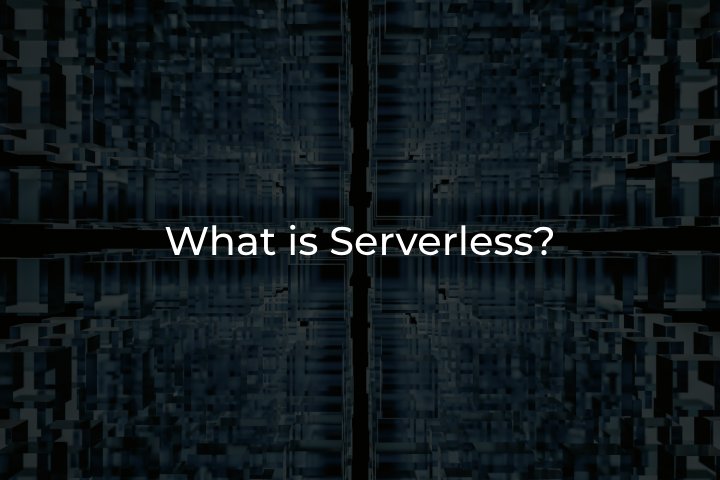
What is Serverless: Introduction, Cost Considerations, Scaling, and Security
Modern software architecture is something that is always evolving and focuses on catering to the needs of a project. One of the recent trends in software architecture includes serverless architecture. One might think serverless means no servers are involved, but that is not quite the case. In serverless computing, we still rely on servers, but we do not have to manage them ourselves. Instead, the cloud provider, e.g., AWS, handles all the infrastructure.
You no longer have to worry about things like server maintenance, patching, updates, or scaling the infrastructure when traffic spikes. It has all been taken care of by AWS. All you need is to just specify your requirements, and AWS does the rest.
This is a game-changer because, in traditional setups, companies hire engineers to constantly monitor the servers, check disk space, update operating systems, and ensure everything runs smoothly. Serverless eliminates that burden, letting teams focus on building features and delivering value.
Serverless at the Front-End
With serverless front-end architecture, there is no infrastructure to patch or update. Everything just works – and because it is served via AWS, you get guaranteed uptime and high availability. It also means there is no server-side attack surface to worry about in the front-end. This means there are fewer security risks associated with things like injections or unauthorized access.
For example, you can use AWS S3 for static asset storage and AWS CloudFront for content delivery. These services are fully managed by AWS, which means there is no server infrastructure to maintain. This setup is highly reliable, scales automatically, and offers your customers a great user experience.
Serverless Backend with AWS Fargate
When it comes to backend infrastructure, managing servers just is not something you want to deal with. So, use AWS Fargate, a serverless compute engine for running containers. With Fargate, you do not have to manage EC2 instances or worry about server maintenance, since AWS does it all for you.
It is pretty simple: you specify the resources you need, deploy your containers, and AWS handles the scaling, updates, and availability. This means you do not have to spend time maintaining servers, checking for patches, or worrying about things like viruses or downtime. It is all handled by AWS, so you can focus on writing code and improving your services.
On the database side, Amazon Aurora PostgreSQL in serverless mode would be a good choice. What is great about Aurora Serverless is that it can scale automatically based on demand. At night, for instance, when traffic is low, the database scales down to save on costs. During peak hours, it scales up to handle more traffic. This elastic scaling helps you optimize your infrastructure costs while ensuring you are ready to handle whatever comes your way.
Backend Security in Serverless
When we talk about the backend, things get a bit more complex. Security is always a priority, no matter the technology you are using – whether it’s Laravel, Python, .NET, or Elixir, backend systems can have vulnerabilities. To keep things secure, we recommend a Web Application Firewall (WAF), specifically AWS WAF. This service helps filter and monitor HTTP requests to ensure that only legitimate traffic reaches your backend.
For example, AWS WAF has been a critical tool for protecting against DDoS attacks, and it is something that is used a lot. It has been tested thoroughly during penetration tests, and some of the results are impressive – 99% of malicious requests were blocked before they even reached the back-end. The remaining requests that did get through were quickly intercepted by the backend logic.
Cost Considerations and Scaling
Now, let’s talk about costs. Serverless architecture is incredibly cost-effective if your system does not have continuous traffic when periods of low usage are followed by traffic spikes. But if your workload is consistently heavy, serverless can become more expensive than using traditional servers.
For example, if you are running a database 24/7 in serverless mode, you could end up paying more than if you simply run an instance. But if you only have peak traffic for a few hours a day, serverless becomes a real cost-saver because you only pay for what you actually use.
It is all about choosing the right service for the right workload. Services like AWS ElastiCache Redis OSS are also used in serverless mode to help manage in-memory data for applications. They handle variable loads, scaling up during working hours when the system is active and scaling down when there is less demand. This flexibility allows you to maintain high performance without the constant overhead of manual management.
When it comes to security, AWS GuardDuty is among the best tools that automatically scans your databases and services for unusual or potentially malicious activities. Built on machine learning, GuardDuty helps you identify security incidents early on. For example, if someone tries to log into your AWS account from an unfamiliar location or uses suspicious credentials, GuardDuty will immediately flag it. If someone makes multiple failed login attempts, that is another red flag for GuardDuty. The system will notify you, and thanks to the integration with Slack or Microsoft Teams, you get an instant alert. You get to know exactly who is trying to do what, and, therefore, react immediately.
GuardDuty is also great at spotting poor security practices. For example, if someone logs in using a Guard account for regular tasks (which is not something you should be doing daily), it will detect this and raise a flag. A Guard account is typically used only for specific, high-level operations, like linking to a bank account, and not for regular system access. GuardDuty alerts users to this kind of anomaly right away.
GuardDuty integrates well with other AWS security services like AWS Security Hub, which provides a centralized view of all security findings and helps you stay compliant with standards like HIPAA and SOC 2. It also provides an overall security score and highlights areas where you can improve.
It also detects abnormal behavior like logging in from an unusual IP address or if a user starts behaving differently than usual. For instance, if a user who usually logs in from one region, suddenly starts accessing the system from a different one, GuardDuty will immediately notify you of this suspicious activity.
Bottomline
Serverless architecture, especially with AWS, simplifies infrastructure management by outsourcing tasks like scaling, maintenance, and updates to the cloud provider. This allows developers to focus on building features rather than managing servers.
For the front-end, AWS services like S3 and CloudFront provide high availability and security without server-side concerns. On the backend, AWS Fargate handles containerized applications, while Aurora Serverless scales automatically based on traffic demands, optimizing costs at the same time. AWS WAF improves security since it helps to block malicious requests and AWS GuardDuty detects suspicious activities.
While serverless is cost-effective for variable traffic, it can become expensive with continuous heavy loads. Overall, serverless offers scalability, security, and cost-efficiency making it an attractive choice for modern software development.


